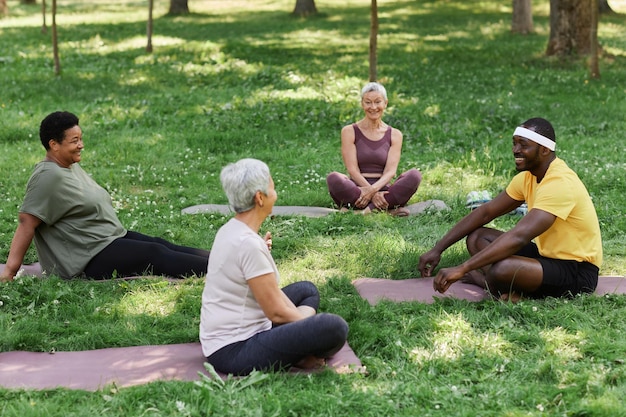Physical Activity & Mental Health in the US: A Deep Dive

The profound link between physical activity and mental well-being in the US underscores a critical need for integrating movement into daily life as a foundational strategy for enhanced psychological health and resilience against common mental health challenges.
In an increasingly complex world, the intricate connection between our physical state and mental well-being has become a focal point of discussion and research. For individuals across the United States, understanding The Connection Between Physical Activity and Mental Health: A US Perspective is not merely academic; it is a vital step toward fostering resilience and improving overall quality of life.
the foundational link: body, mind, and the american context
The symbiotic relationship between the body and mind has been acknowledged for centuries, but modern science, particularly in the United States, continues to illuminate its profound implications for mental health. This section delves into how physical activity influences the brain and contributes to psychological well-being, specifically within the diverse landscape of American society.
In the US, lifestyle trends often lean towards sedentarism, making the active pursuit of physical well-being even more critical. The pressures of modern life, characterized by long working hours, reliance on digital devices, and often fragmented social structures, can contribute to heightened stress levels and mental health conditions. Engaging in regular physical activity provides a powerful counter-narrative to these trends.
neurobiological benefits of exercise
Exercise isn’t just about building muscle or losing weight; it triggers a cascade of neurochemical changes that profoundly impact mood and cognition. Understanding these mechanisms helps underscore why physical activity is so potent for mental health.
- 📈 **Endorphin Release:** Often dubbed “feel-good” chemicals, endorphins produced during exercise can alleviate pain and induce feelings of euphoria, commonly known as a “runner’s high.”
- 🧠 **Neurotransmitter Regulation:** Physical activity helps regulate key neurotransmitters like serotonin, dopamine, and norepinephrine, all crucial for mood, motivation, and stress response.
- 🌱 **Brain-Derived Neurotrophic Factor (BDNF):** Exercise boosts BDNF, a protein that promotes the growth of new brain cells, enhancing brain plasticity and potentially mitigating neurodegenerative processes.
These biological shifts contribute directly to improved mood, reduced anxiety, and enhanced cognitive functions, creating a more resilient mental state. The scientific community in the US has extensively researched these pathways, providing robust evidence for the therapeutic effects of exercise.
societal implications and access disparities
While the benefits are universal, access to and engagement in physical activity can vary significantly across different US communities. Socioeconomic factors, urban planning, and cultural norms play a substantial role in determining how easily individuals can incorporate exercise into their lives.
Disparities in access to safe outdoor spaces, affordable gym memberships, and community sports programs highlight a critical challenge. Addressing these inequities is essential for ensuring that the mental health benefits of physical activity are accessible to all Americans, not just a privileged few.
From bustling city centers to vast rural expanses, the American experience with physical activity is incredibly varied. Promoting mental wellness through movement requires a nuanced understanding of these local contexts and tailored solutions that resonate with diverse populations.
combating anxiety and depression through movement
Anxiety disorders and depression are among the most prevalent mental health conditions in the United States, affecting millions of adults and increasingly, younger populations. While therapy and medication are cornerstone treatments, physical activity has emerged as a powerful, evidence-based complementary strategy for managing symptoms and promoting recovery.
Insights from numerous studies and clinical observations in the US consistently show that regular exercise can be as effective as some pharmacological treatments for mild to moderate depression. For anxiety, it provides immediate relief and builds long-term coping mechanisms.
exercise as an anxiolytic and antidepressant
The anti-anxiety and antidepressant effects of physical activity are multifaceted, encompassing biological, psychological, and social dimensions. It offers a holistic approach that addresses various aspects of mental distress.
- 🧘 **Stress Reduction:** Exercise provides a healthy outlet for pent-up stress, reducing physiological markers like cortisol and promoting a sense of calm.
- 😴 **Improved Sleep Quality:** Many individuals struggling with anxiety and depression experience sleep disturbances. Regular physical activity can regulate sleep patterns, leading to more restorative rest.
- boost **Self-Efficacy and Self-Esteem:** Achieving fitness goals, even small ones, can boost confidence and a sense of accomplishment, counteracting feelings of helplessness often associated with depression.
The ritual of exercise, whether it’s a daily walk or a demanding workout, can also create a structured routine that provides stability. This structure is particularly beneficial for individuals whose lives may feel chaotic due to mental health challenges.
case studies and public health initiatives
Across the US, various public health initiatives and community programs are leveraging physical activity to address mental health concerns. From school-based interventions promoting movement breaks to city-wide campaigns encouraging active lifestyles, the focus is shifting towards prevention and holistic support.
Many clinical practices are now integrating exercise prescriptions into treatment plans for patients with mood disorders, recognizing its therapeutic value. Programs that combine physical activity with mindfulness or cognitive behavioral techniques show particular promise, offering a comprehensive approach to mental wellness.

enhancing cognitive function and resilience
Beyond alleviating symptoms of specific mental health disorders, physical activity plays a crucial role in enhancing overall cognitive function and building psychological resilience. In a demanding society like the US, cognitive sharpness and the ability to bounce back from adversity are invaluable assets.
Regular exercise improves memory, attention, and executive functions—the cognitive processes that help us plan, organize, and execute tasks. These improvements are critical for academic success, professional performance, and navigating daily life effectively.
the brain-boosting power of movement
The mechanisms through which physical activity boosts cognitive function are rooted in its impact on brain structure and connectivity. It promotes a healthier, more efficient brain that is better equipped to handle cognitive demands and stress.
- circulate **Enhanced Blood Flow:** Exercise increases blood flow to the brain, delivering more oxygen and nutrients vital for optimal brain function.
- synapse **Neurogenesis and Synaptogenesis:** It stimulates the growth of new neurons, particularly in the hippocampus (a region critical for memory), and strengthens synaptic connections, leading to more efficient brain communication.
- inflammation **Reduced Inflammation and Stress:** Chronic inflammation and stress can impair cognitive function. Exercise helps reduce systemic inflammation and modulates the body’s stress response.
Long-term adherence to an active lifestyle is associated with a reduced risk of cognitive decline in later life, including conditions like Alzheimer’s disease. This preventive aspect of physical activity is of growing importance in the aging US population.
resilience building and coping mechanisms
Physical activity also cultivates psychological resilience by teaching individuals valuable coping skills and fostering a sense of mastery. Pushing physical limits, even slightly, can translate into mental fortitude.
When faced with the demands of a workout, individuals learn to persevere through discomfort, manage frustration, and celebrate small victories. These experiences build self-efficacy and the belief that one can overcome challenges, which are critical components of resilience.
Furthermore, team sports or group fitness classes can provide opportunities for social interaction and support, acting as a buffer against isolation—a known risk factor for poor mental health. These communal activities are particularly important in a society where social connections can sometimes be strained.
addressing specific populations: us youth and seniors
The impact of physical activity on mental health extends across the lifespan, but its implications for specific demographic groups in the US, such as youth and seniors, warrant particular attention. Each group faces unique challenges and opportunities regarding physical activity and mental well-being.
For young people, sedentary lifestyles and excessive screen time are growing concerns that can negatively affect developing brains and increase risks for mental health issues. For seniors, maintaining physical activity is crucial for cognitive preservation, mood regulation, and combatting loneliness.
youth mental health and activity levels
The mental health crisis among US youth is a pressing concern, with rising rates of anxiety, depression, and stress. Physical activity offers a potent yet often underutilized tool in prevention and intervention strategies for this age group.
- 🏫 **Academic Performance and Focus:** Regular physical activity can improve concentration, attention span, and overall academic performance in students, leading to reduced stress around schoolwork.
- peer **Social Development:** Participation in sports and active play fosters teamwork, communication, and social skills, reducing feelings of isolation and building healthy peer relationships.
- emotion **Emotional Regulation:** Exercise provides a healthy outlet for managing emotions, helping young people cope with stress, anger, and sadness more effectively.
Initiatives in US schools, like daily physical education classes, recess, and after-school sports, are vital. However, budget cuts and increasing academic pressures have sometimes led to a reduction in these essential programs, inadvertently impacting youth mental health.
senior well-being and active aging
As the US population ages, promoting active aging becomes paramount for mental and physical health. Physical activity can significantly impact seniors’ cognitive function, mood, and social engagement, combating common issues like dementia and isolation.
For seniors, accessible and low-impact activities like walking, swimming, chair yoga, and tai chi can provide substantial benefits. These activities not only maintain physical function but also offer opportunities for social interaction and a sense of purpose.
Community centers and senior programs across the US are increasingly incorporating physical activity classes tailored to older adults. These programs offer structured opportunities for movement and provide vital social connections, combating loneliness and promoting overall well-being.
integrating activity into daily life: practical tips for americans
While the benefits of physical activity for mental health are clear, the challenge for many Americans lies in consistently integrating movement into their busy daily lives. This section offers practical, achievable tips and strategies to help individuals in the US overcome common barriers and embrace a more active lifestyle for improved mental wellness.
The key is often to start small, find activities that bring joy, and gradually build momentum. Consistency triumphs over intensity, especially when the goal is sustainable mental health benefits.
overcoming common barriers
Many Americans face similar hurdles when trying to become more active, including lack of time, motivation, and access. Addressing these challenges directly can pave the way for success.
- ⏰ **Time Management:** Break down workouts into shorter, manageable chunks throughout the day (e.g., three 10-minute walks instead of one 30-minute session).
- 💡 **Motivation Killers:** Find an activity you genuinely enjoy, whether it’s dancing, hiking, or gardening. Exercise doesn’t have to feel like a chore.
- 💸 **Cost and Access:** Utilize free resources like public parks, walking trails, and online exercise videos. Home workouts require minimal equipment and can be highly effective.
Building a supportive environment, whether through accountability partners or community groups, can significantly boost adherence. In the US, local walking clubs, community sports leagues, and park programs offer excellent non-intimidating avenues for engagement.
diverse activities for diverse needs
There’s no one-size-fits-all approach to physical activity. What works for one person might not work for another. Exploring a variety of options can help individuals find their ideal fit for sustained engagement and mental health benefits.
Beyond traditional sports or gym workouts, consider activities that promote mindfulness and connection with nature, such as hiking in national parks or practicing yoga outdoors. The combination of nature exposure and physical movement has unique mental health advantages.
Even incorporating more movement into everyday routines—like taking the stairs instead of the elevator, parking further away, or walking during phone calls—can accumulate significant benefits over time. These small changes are highly sustainable and contribute to an overall more active lifestyle.

the role of policy and community in promoting activity
While individual effort is crucial, the broader societal structure, policies, and community support play a pivotal role in enabling physical activity across the US. A comprehensive approach involves governmental initiatives, urban planning, and local programs that make healthy choices easier choices.
From pedestrian-friendly infrastructure to corporate wellness programs, a supportive environment can significantly influence how active Americans are and, consequently, their mental well-being. This requires collaboration across various sectors.
urban planning and accessible spaces
The design of our cities and towns directly impacts opportunities for physical activity. Creating walkable communities, expanding public parks, and ensuring safe cycling paths are critical for promoting movement.
- 🌳 **Green Spaces:** Access to parks and nature preserves has been linked to lower rates of depression and anxiety. Urban planning should prioritize the creation and maintenance of these vital green spaces.
- 🚶 **Walkable Communities:** Sidewalks, pedestrian crossings, and mixed-use zoning encourage walking as a primary mode of transportation, integrating activity into daily commutes.
- 🚲 **Safe Cycling Infrastructure:** Dedicated bike lanes and trails make cycling a safer and more appealing option for recreation and transportation.
Many US cities are increasingly investing in such infrastructure, recognizing the long-term health and economic benefits. These investments create a built environment that naturally promotes physical activity and mental wellness.
workplace wellness and corporate responsibility
Given the significant amount of time Americans spend at work, workplace wellness programs offer a unique opportunity to promote physical activity and support mental health. Employers have a role in fostering a culture that prioritizes well-being.
This can include offering gym memberships or on-site fitness facilities, encouraging walking meetings, providing standing desks, and organizing corporate sports leagues. Beyond direct activity, flexible work schedules can allow employees more time for personal fitness.
The benefits extend beyond individual employee health to increased productivity, reduced absenteeism, and improved morale. Forward-thinking companies in the US are increasingly recognizing the strategic importance of investing in employee well-being.
future outlook: a holistic approach to us mental health
The growing recognition of The Connection Between Physical Activity and Mental Health: A US Perspective signifies a paradigm shift towards a more holistic approach to well-being. Looking ahead, the future of mental health in the United States will increasingly integrate physical activity as a foundational pillar alongside traditional therapeutic interventions.
This integrative model promises not only to address existing mental health challenges but also to foster a more resilient and mentally robust population. It emphasizes prevention and proactive engagement in healthy lifestyle behaviors.
research and innovation
Continued research will further refine our understanding of the precise mechanisms through which exercise impacts mental health, enabling more targeted and personalized interventions. Innovation in wearable technology and digital health platforms will also play a role in monitoring activity levels and providing personalized feedback and motivation.
The development of evidence-based exercise prescriptions for various mental health conditions will become more commonplace in clinical settings, ensuring that physical activity is integrated into standard care protocols.
policy advocacy and public education
Sustained advocacy for policies that support active lifestyles at all levels—from federal health initiatives to local community planning—will be crucial. Public education campaigns emphasizing the mental health benefits of exercise will help shift cultural norms and encourage greater participation across all demographics.
Ultimately, making physical activity an accessible and enjoyable part of daily life for every American is a collective responsibility. By fostering environments that encourage movement and educating individuals about its profound mental health benefits, the US can move towards a future where physical and mental well-being are inextricably linked and equally prioritized.
| Key Aspect | Brief Description |
|---|---|
| endorphin **Neurochemical Boost** | Exercise releases “feel-good” chemicals like endorphins and regulates crucial neurotransmitters, directly enhancing mood and reducing stress. |
| anxiety-depression **Mental Health Ally** | It serves as a powerful complementary strategy for managing and preventing symptoms of anxiety and depression, improving sleep and self-esteem. |
| brain **Cognitive Enhancer** | Boosts blood flow, fosters neurogenesis, and reduces inflammation, leading to improved memory, attention, and overall brain function. |
| community **Societal Impact** | Policy, urban planning, and community support are crucial for widespread integration of physical activity, making it accessible to all US populations. |
frequently asked questions
▼
For significant mental health benefits, adults in the US are generally advised to aim for at least 30 minutes of moderate-intensity aerobic activity most days of the week, totaling 150 minutes weekly. Even shorter bursts of activity accumulating throughout the day can also be beneficial, providing mood boosts and stress reduction.
▼
While physical activity is a powerful tool for improving mental health and can be as effective as some treatments for mild to moderate depression or anxiety, it is generally considered a complementary strategy. It should not replace prescribed therapy or medication without consulting a healthcare professional. It works best as part of a comprehensive treatment plan.
▼
The best types of physical activities for mental well-being are those you enjoy and can consistently stick with. Aerobic exercises like running, swimming, or cycling are excellent, but strength training, yoga, dancing, and even gardening also provide significant benefits. Group activities can add a social dimension, which further supports mental health.
▼
Physical activity helps manage stress in several ways. It serves as a healthy distraction from worries, reduces the body’s stress hormones like cortisol, releases endorphins that promote feelings of well-being, and improves sleep quality, which is crucial for coping with stress. Regular movement also builds resilience, enhancing your ability to handle future stressors.
▼
When starting any new exercise routine, especially for mental health, it’s wise to begin slowly and gradually increase intensity and duration to avoid injury. Consult your healthcare provider, particularly if you have underlying health conditions or are taking medications. Listening to your body and prioritizing enjoyment over extreme intensity will ensure a safe and sustainable approach.
conclusion
The evidence overwhelmingly supports the multifaceted benefits of physical activity for mental health in the United States. From neurochemical enhancements and cognitive improvements to powerful anxiolytic and antidepressant effects, movement is a cornerstone of overall well-being. As we continue to navigate the complexities of modern life, integrating consistent physical activity into our routines is not just an option, but a vital investment in our psychological resilience. By fostering supportive environments and promoting diverse forms of movement, we can empower individuals across the nation to harness this powerful connection and build a healthier, more mentally robust society.





